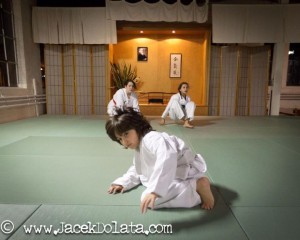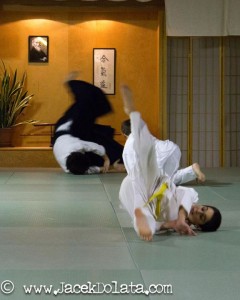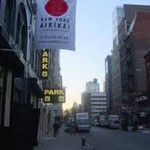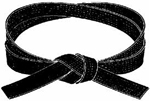 From Sunday July 29th – Saturday August 4th we will all be converging at the Dolce Seaview Hotel and Resort in Galloway, New Jersey for another stellar week of Aikido and luxury. Hosted by Yamada Sensei and guest instructor Osawa Sensei, along with the USAF Technical Committee and other USAF Shihan and instructors, we will celebrate our 4th year at this outstanding facility. After the New Year, the summer camp committee will circulate more information both through this newsletter and the USAF Summer Camp facebook page. So mark your calendars and stay tuned for further updates! See you in 7 months and 6 days…
From Sunday July 29th – Saturday August 4th we will all be converging at the Dolce Seaview Hotel and Resort in Galloway, New Jersey for another stellar week of Aikido and luxury. Hosted by Yamada Sensei and guest instructor Osawa Sensei, along with the USAF Technical Committee and other USAF Shihan and instructors, we will celebrate our 4th year at this outstanding facility. After the New Year, the summer camp committee will circulate more information both through this newsletter and the USAF Summer Camp facebook page. So mark your calendars and stay tuned for further updates! See you in 7 months and 6 days…
Archives for 2011
Save The Date – USAF Summer Camp 2012
Aikido Roll-A-Thon Raises Funds For Local Food bank
 Press Release: Litchfield Hills Aikikai is proud to announce the results of the Aikido Youth Program Roll-a-Thon held on Monday, December 12th. The children completed 4,490 Aikido rolls in ½ hour, and because of their outstanding efforts and dedication to this cause, they raised $1650 in sponsored donations Upon completing their rolls, the funds were presented to Kevin Purcell of Torrington FISH to help support the local food bank during the holidays and winter months ahead. As Sensei Laura Pavlick stated, “This was a special moment for the kids – they worked so hard, set their own goals, worked with such concentrated effort towards those goals, and gave back to their community in a huge way. This touches on so many important lessons – what a great experience. We are all so proud of them.”
Press Release: Litchfield Hills Aikikai is proud to announce the results of the Aikido Youth Program Roll-a-Thon held on Monday, December 12th. The children completed 4,490 Aikido rolls in ½ hour, and because of their outstanding efforts and dedication to this cause, they raised $1650 in sponsored donations Upon completing their rolls, the funds were presented to Kevin Purcell of Torrington FISH to help support the local food bank during the holidays and winter months ahead. As Sensei Laura Pavlick stated, “This was a special moment for the kids – they worked so hard, set their own goals, worked with such concentrated effort towards those goals, and gave back to their community in a huge way. This touches on so many important lessons – what a great experience. We are all so proud of them.”
In addition to Mr. Purcell attending the event to watch the children work tirelessly towards their goals, Litchfield First Selectman Leo Paul was there to show his support as well. The local flavor of the event was topped off with other contributors: a special thanks to Bantam Market for its support – their donation of snacks and drinks was greatly appreciated by the kids after all their hard work was done; local artist Elizabeth Wolff for providing her great art work for the documents and certificates; and photographer Jacek Dolata for his outstanding pictures which capture the essence of this important project. Click here to the photos of this.
To learn more about the Aikido Dojo go to www.litchfieldaikido.com
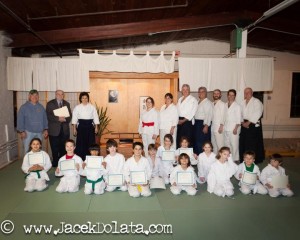
Holiday Greetings From Yamada Sensei
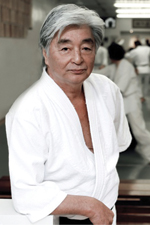 I can truly say it’s good to be home! I have traveled all over the world and coming home to NY to finish the year at my dojo always makes me happy.
I can truly say it’s good to be home! I have traveled all over the world and coming home to NY to finish the year at my dojo always makes me happy.
It’s hard to believe that another year has passed, but when I look on the back of my office door at my calendar for 2012, I think that the new year will be just as busy. Even though I am tired from traveling so much, every where I go the aikido is growing and the people are excited to learn. Many people who live in countries where they have to struggle every day are so happy on the mat. It makes my job so much easier because of that. And as always, being at our own Summer Camp is one of my favorite weeks of the year – it makes me very proud to see so many members coming to camp, and now they are bringing their families. As you know, I love children and as we are all getting older, this seems to make it feel more complete.
The Board and Technical Committee meetings every year are usually very long, but I sit through them because I know how important it is to listen to what our members are discussing and see how hard they are all working to keep the USAF the best aikido organization possible. They have worked very hard this year to make sure that the future is in order for the USAF to continue in a strong and positive way. The TC will be in touch with instructors this year to discuss suggestions for how to improve our teaching curriculum and they will continue to work with the Board towards providing the best benefits for our members possible. Next fall will be the IAF meeting in Japan, where I will go with representatives from the Board of Directors and Technical Committee. Since this happens only every 4 years, we will spend a lot of time preparing for the meeting so we can have a good voice representing the future of the USAF.
As usual, I would like to thank everyone who came to the christmas seminar at New York Aikikai this year. We had close to 250 people here, and 46 tests. I like to be at my dojo when members and visitors from all over the world are all around me. It feels like the dojo is alive and home to everyone.
As I sit in my office and listen to the song “There’s no place like home for the holidays,” I think they are right.
Sincerely,
Y. Yamada
New York Aikikai’s Christmas Seminar & Testing Information
Dear Aikidoka:
New York Aikikai will be hosting its annual holiday seminar on December 17th-18th. Information about this great event can be found through the link on their home page, www.nyaikikai.com.
If you, your student or your friend will be testing at the NYA seminar, please be aware that all test payments will be collected separately from the seminar fee payments. That is, all seminar fees will be payable to NYA, and all dan test fees will be payable to the USAF. For the seminar fee, NYA will accept cash, checks, or credit cards, which will be charged at the time of registration.
Please be prepared to make 2 payments if you will be testing, with your test payment in cash or by check made payable to the USAF. If you would like to pay with Mastercard or VISA (not Amex or Discover), you will be asked to fill out a credit card form authorizing the USAF to charge your card at a later date – your card will not be charged on the day of your test, but rather at a later time from the USAF office.
In addition, please remember that all dan applications need to be typed. They are available online through your instructor or dojo-cho in a fillable pdf format. There are 4 forms for shodan, and 2 for nidan and sandan. Shodan is $200, nidan is $250 and sandan is $300. Please come prepared with your paperwork and payments ready to be handed in. With the number of seminar participants and dan tests, this will help the process remain as efficient as possible. It’s always an exciting day, so your help with this will be greatly appreciated!
Thank you so much for passing on this important information. See you next week.
Sincerely yours,
Laura Pavlick
Director of Operations
New Resource Available to USAF Dojo-cho
 USAF Dojo-cho and instructors were recently asked to submit information regarding their dojo insurance carriers as well as their direct billing companies. This information is now available, and a detailed email has been circulated to all Dojo-cho. This is the beginning of the new resource center for USAF instructors where we will share, based on our own experiences, not just information regarding insurance and billing companies, but also where we shop for dojo supplies, who are our web developers or logo designers, our favorite kids class games, Q&As, and much more.
USAF Dojo-cho and instructors were recently asked to submit information regarding their dojo insurance carriers as well as their direct billing companies. This information is now available, and a detailed email has been circulated to all Dojo-cho. This is the beginning of the new resource center for USAF instructors where we will share, based on our own experiences, not just information regarding insurance and billing companies, but also where we shop for dojo supplies, who are our web developers or logo designers, our favorite kids class games, Q&As, and much more.
Members of the USAF Board have undertaken extensive research into insurance options for USAF dojo. While no solution has been found yet that can cover the broad spectrum of our needs, we are talking with a company right now about a few possibilities and a brief questionnaire may be circulated shortly.
As the success of this new resource is based on our group participation, thank you to all who provided the information which helped launch this exciting project. We each hold much knowledge based on our own personal experiences teaching Aikido and running a dojo, and exchanging this will create a wealth of information while supporting each other in our shared endeavors.
The Winter Seminar 11-11-11
 Florida’s Winter Seminar was a perfect storm this year. All systems go – the weather, the Sensei, the etiquette discussion – the aikido group was charged with energy. Click here to view the pictorial account which gives you a true sense of magic on the beach.
Florida’s Winter Seminar was a perfect storm this year. All systems go – the weather, the Sensei, the etiquette discussion – the aikido group was charged with energy. Click here to view the pictorial account which gives you a true sense of magic on the beach.
To give you some history about the seminar, Yamada Sensei began organizing the annual event in Florida in 1979. There was a small dojo in Ft. Lauderdale and he asked us to help him set up an end of the year meeting for the United States Aikido Federation with a seminar. The intension was to host the USAF meeting in Florida for one year and then it would move around the country. It never moved. We had a successful first year. And every year since Yamada Sensei says to me after the seminar “OK let’s do it here again. I want to come back next year”– 32 years later we are still here.
I had the opportunity to interview Yamada Sensei at this year’s seminar to talk about the history of the Winter Seminar and his role in it. He told me that the event is a reflection of Aikido in the United States. We started with nothing, now we have 400 people on the mat! It is great to hear his account. Please enjoy the video moment with me.
I also had the opportunity to interview each of the USAF Technical Committee – Harvey Konigsberg, Claude Berthiume, Peter Bernath, Donovan Waite, Bob Zimmermann, Steve Pimsler, and Andy Demko. Stay tuned and view see a mix of their interviews and their winter seminar classes.
A special thank you goes to Dominic Flores, whose amazing photography is now on display in the official Winter Seminar Photo Album,
and to Jonathan Weiner who created our special videos of Winter Camp, as seen here in the Interview with Yamada Sensei, and the teaser for USAF Technical Committee Interviews
Every year the seminar gets better. Don’t miss out on the fun. See you next year!
Penny Bernath
6th dan, Shidoin
Florida Aikikai
The Forge
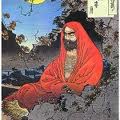 As ideas migrate they change as they stay the same. This seems to happen in much the same way that people pass on genetic characteristics. If one tribe with black hair intermarries with another tribe that has blonde hair then occasionally a recessive gene expresses itself and an atypical physical attribute expresses itself… but although this particular child may look different then the others s/he is still a member of the same tribe and the tribe retains its basic culture and identity.
As ideas migrate they change as they stay the same. This seems to happen in much the same way that people pass on genetic characteristics. If one tribe with black hair intermarries with another tribe that has blonde hair then occasionally a recessive gene expresses itself and an atypical physical attribute expresses itself… but although this particular child may look different then the others s/he is still a member of the same tribe and the tribe retains its basic culture and identity.
The concept of Budo is the result of a similar process of migration as an idea that starts in India, travels and transmutes through Asia, until it eventually arrives in Japan to be influenced by a Samurai world view.
It seems to have begun when a man (Siddhartha Gautama/Shakyamuni) somewhere in Nepal decided to sit under a tree until he found “an end to suffering” (enlightenment). Legend says that this practice was carried to China by Bodhidharma where it intermingled with Taoism and where sitting is called Ch’an. Tradition stipulates that Bodhidharma sat facing a wall in a cave near a Shaolin Monastery for nine years. Although he was silent he left behind an iron chest with two texts. The first text disappeared but the second text, “The Muscle Change Classic”, became the guarded treasure of the monks who incorporated it into their martial arts practice.
This association of Bodhidharma with the idea that spiritual, intellectual, and physical excellence are an indivisible whole necessary for enlightenment, proved highly attractive to the Samurai class in Japan. As the idea crosses the sea from the continent to the islands Japanese pronunciation transforms “Tao” to “Do” and “Ch’an” to “Zen”.
As a warrior class Samurai were constantly aware of their mortality, a human condition that often leads to questioning the meaning of existence. They were particularly drawn to the Rinzai School of Zen because it was reputed to remove all fear of death via direct experiential transformation of consciousness. For a Samurai, fear of death was naturally a great obstacle, so such Zen practice had practical applications and became the philosophical basis of bushido. Bushido demands the willingness to face death. According to Zen principles, fear can only be truly conquered by eliminating the notion of self. It is from here that the migrating idea of the Buddha becomes the Japanese concept of Budo.
The sword is known as the “soul of the Samurai”, and in Japanese mythology it was one of the three sacred gifts given to the emperor by the Sun Goddess. A Samurai’s sword was believed to be imbued with certain spiritual qualities of its owner. The forging of the blade itself was considered a religious ceremony, swathed in ritual, passed down in secret from father to son for generations. The ceremony was consistent, precise, unvaried, and beautiful — in action, dress, and color. Forging was often done at night and temperatures were set by holding the blade to the color of the morning sun. The exact hue was transmitted from master to apprentice down through centuries.
The sword forging process itself became a metaphor for character development and many of the metallurgical processes parallel the tasks required for shaping the spirit. The concept of “tanren” is central to this theme.
Tanren means to forge in the same way that a sword blade is forged, with hard work, and sweat, and many hours of dedication, folding together the hard and soft elements in the body, mind, and movement just as the sword gains its strength out of hard and soft steel.
This is followed by “Renshu”. Ren means to polish, to perfect by continued practice. It also means to polish the spirit and character through the requirements of detail and interpretation. To demonstrate a compassionate nature that can pass on knowledge without egotistical pride and arrogance. Miyamoto Musashi, the legendary 16th century Japanese sword master, states in his “Book of Five Rings” that it takes 1,000 days to forge the spirit and 10,000 to polish it.
So it came to be in more modern times (in Japan this could be seen as starting with the Meiji Reformation) that a primary goal of Budo was to develop character. The physical practice of Budo transcends the notion of sport. It transcends the idea of competition. It views self-defense in a much more sophisticated way.
Because of such a great promise there are high expectations. Wherever there is a great height there is the danger of a great fall. This is as true with abstract ideals as it is with concrete reality. There is the “talk” about the ideals of Budo and the “walk” of the path. Disappointments and errors occur along the journey and the fall is accompanied by sadness and doubt.
But part of the training in Budo is to learn how to fall and arise from the throw ready to continue. Consequently one must remember that there is “no escape” and readjust the keikogi and return to “fight the good fight”. This doesn’t mean that the experience hasn’t left feelings of doubt and discouragement. These are the challenges (physical and psychological) to training and living. They are the heat and the hammering that represents the forging of character.
This is the difficulty of living with integrity in the “real world” and the hardships experienced along the way. These are the requirements for forging a blade that “never bends, never breaks, cuts clean”.
R. A. Whelan
Godan, Shidoin
Shodokan
Kawahara Shihan
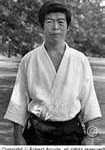 After training in the CAF for a number of years, I moved to North Carolina for a work opportunity and Kawahara Sensei asked me to study with a USAF dojo. I have now been a student of Steve Kaufmann at Open Sky Aikikai since 2004. I wrote a piece on my blog about Kawahara Sensei, and Kaufman Sensei has encouraged me submit this for others to see. It begins as follows:
After training in the CAF for a number of years, I moved to North Carolina for a work opportunity and Kawahara Sensei asked me to study with a USAF dojo. I have now been a student of Steve Kaufmann at Open Sky Aikikai since 2004. I wrote a piece on my blog about Kawahara Sensei, and Kaufman Sensei has encouraged me submit this for others to see. It begins as follows:
Yukio Kawahara Shihan, 8th dan, the technical director of the Canadian Aikido Federation, a direct student of O Sensei and a very gifted, very generous and gracious man, passed away late on June 2nd. According to the shidoin who phoned me, he was surrounded by his students.
I’ve tried to blog about Sensei several times, and I always end up deleting the entry. He was a private man by choice and never sought the limelight. He was also careful about his legacy and cautious about what he taught to whom. He was a strong advocate of practice, and I think he considered our practice more important than any ceremony directed at himself.
To continue reading the blog post, click here
John Hillson
Open Sky Aikikai
Thank you O-Sensei
 It’s only been 4 years since I started learning your Aikido. Aikido has been one of the best things that have happened to me in my life.
It’s only been 4 years since I started learning your Aikido. Aikido has been one of the best things that have happened to me in my life.
My earliest memory of Aikido came from, of all places, Sesame Street. There was a very short video clip of an aikido demonstration performed by two kids. I was already mesmerized by the miracles of the television. This little video stayed engrained in me.
So, here I am many, many years later. I’ve grown to adulthood and have a family of my own. What do I run into but Aikido. What a blessing it has been! Don’t get me wrong, it wasn’t a pretty start. My very first attempt at Aikido was terrible. I entered the dojo and went to a few classes. Things just didn’t go right at first. I couldn’t do rolls without getting very dizzy. I became so ill that I could not continue my aikido training at that time.
A few years later, I ran into a cousin, who was studying Aikido as well. This peeked my interest once again, so much so that when I got home I looked up the local Aikido Dojo and signed up.
I feel very lucky to have met the instructors of this dojo (Southern Maryland Aikido Center). They are the nicest couple. Yes, they are a husband and wife team of Aikido Instructors. They made all my past Aikido issues go away; leaving only the pure joy of Aikido. Donna and Darrell are teaching us (my fellow Aikido students and me) the beauty and power of Aikido. They are the best of examples for our young dojo. The future of Aikido in our little part of the world is safe.
So, as I was saying I’m very new to Aikido. I attend Aikido classes almost every day the dojo is open. I’ve also been able to attend some of the local seminars. Aikido makes me feel great inside. I have a yearning to learn more as I progress. I see the beauty of Aikido; the graceful movements of uke and nage blending.
I thank O-Sensei for sharing his creation with us. He has changed countless lives and now my life can be added to that list as well.
Domo arigato gozaimasu, O-Sensei.
Rey N. Robles
Southern Maryland Aikido Center
July 2011
Dan Promotions 5/16/2011 – 9/15/2011
Test applications received and dated between May 16, 2011 and September 15, 2011
Shodan
- Daniel Addario – Jersey Shore Aikikai
- Jeremy Anglin – Litchfield Hills Aikikai
- Patrick Chen – Muso Aikido
- Hilary Hess – Aikido of Champlain Valley
- Linda Hovan – Granite State Aikido Club
- Benoit Jolicoeur – Aikido de la Montagne
- Sergey Kushnir – Aikido of Central New York
- Vincent Lecomte – Aikido de la Montagne
- Paul Luukkonen – Toronto Aikikai
- Lawrence McLennon – Aikido Institute of Newfoundland
- Ezzard Neri – Toronto Aikikai
- Ronald Oltmanns – Aikido of Denton
- Sunil Pasi – Northern Virginia Aikikai
- Jeff Rotondi – Aikido of Ramapo Valley
- James Russo – Suffolk Institute for Eastern Studies
- Ross Setlow – Albany Aikido
- Anastasia Shiba – Newport Beach Aikikai
- Samantha Taitel – Aikido Center of Dover
- Chuck Teubert – Lenape Aikikai
- Matthew Wavro – Aikido of Red Bank
- Jennifer Yabut – Jersey Shore Aikikai
Nidan
- Heath Atchley – Aikido of Northampton
- Zbigniew Bloch – Toronto Aikikai
- Stefan Dromlewicz – Framingham Aikikai
- Krista Gile – Aikido of Northampton
- Neal Harrison – Newport Beach Aikikai
- Lois Miraucourt – Aikido de la Montagne
- Alexander Perry – Aikido of Champlain Valley
- Benjamin Polikarpov – Toronto Aikikai
- Jamal Teymouri – Albany Aikido
- Brian Tobin – Toronto Aikikai
- Carla Wells – Newport Beach Aikikai
Sandan
- Joao Alcantara – Newport Beach Aikikai
- Jesse Earl Brown – Naka Ima Aikikai
- Charles Dubois – Aikido de la Montagne
- Vincent Hauser – Austin Aikikai
- Debi Hron – Aikido of Champlain Valley
- Steve Kopka – Midwest Aikido Center
- Takayuki Koei Kuwahara – New England Aikikai
- Jason Pepe – Aikido of Champlain Valley
- Jason Perna – Aikido of Center City
- Stefan Pisocki – Diamond State Aikido
- Henry Rauchweld – Aikido of Ramapo Valley
